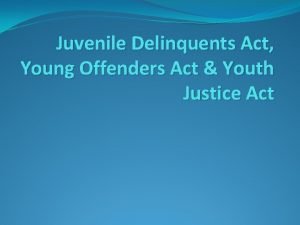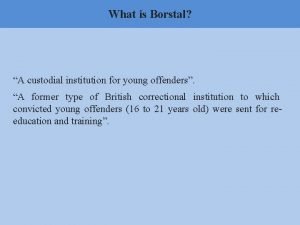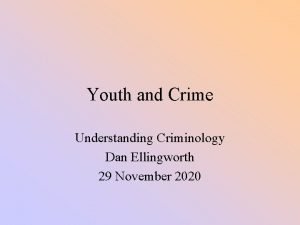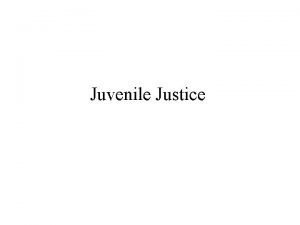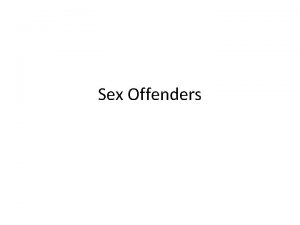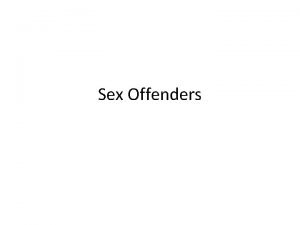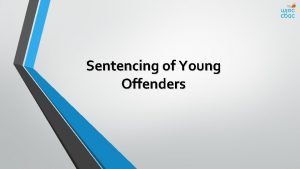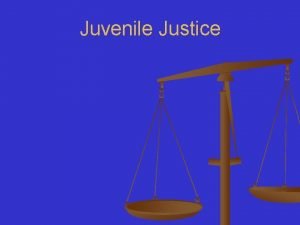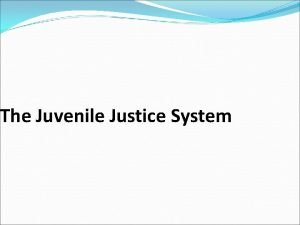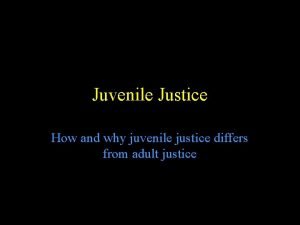Juvenile Delinquents Act Young Offenders Act Youth Justice












- Slides: 12

Juvenile Delinquents Act, Young Offenders Act & Youth Justice Act

Youth & the Law �Serious violent crimes represent a small fraction of crimes committed by youth �Incapacity of children: children under 12 cannot form the necessary mens rea to be convicted. �Searches: police can search youths without a warrant if they have reasonable grounds to believe that the search will uncover evidence that would be lost �Youth are entitled to a lawyer and proper legal advice

Publication of Identities �Media can report on youth trials but cannot publish the names of the youth offenders as they want to avoid prejudice and stigmatization. �Youth Justice Court �Court for those between the ages of 12 and 17 who have been charged with a criminal offence �Community Based Measures �For first time, non-violent offenders who have accepted responsibility for their actions, no charges are laid, but they must agree to participate

Sentencing Options �Hold young people accountable in a fair and meaningful way that aids in rehabilitation, the court looks at the following: �Harm done �Reparations made �Time spent in detention �Other crimes committed �Victim impact statement �Extent of participation

Pre-Sentence Report �Gives background information on the offender—helps the judge determine an appropriate sentence �Secure Custody: �Remove young persons from the community and incarcerate them in a secure facility, they are a threat to public safety �Conferences: �Help determine the appropriate action, youth, the victim, and the parents meet and decide what action would be most appropriate, the community is involved —it is more healing.

Juvenile Delinquents Act 1929 � Was a law passed in 1908 by the Canadian government to improve its handling of juvenile crime. It established procedures for the handling of juvenile offenses, including the government assuming control of juvenile offenders. It was revised in 1929 and superseded in 1984 by the Young offenders Act. � For most of its history, Canada's legal system has treated young people and adults differently. Under English common law, children between the ages of 7 and 13 were usually not charged for criminal offenses. It was believed they could not understand the seriousness of their actions. If it could be proven that a child could form criminal intent, he or she would be charged and tried in the same courts as adults. � Children 14 or older were tried in adult courts and were subject to the same penalties as adults: hanging, whipping, or imprisonment. Children and teenagers were forced to serve their sentences alongside adult offenders.

Cont’d �The objective of the Juvenile Delinquents Act was to rehabilitate and reform—not to punish. Young people who broke the law were delinquents—not criminals. They were viewed as victims of poverty, abuse, and neglect. Their parents had failed to raise them well, it was reasoned, so the state assumed custody of the child. �Gender stereotypes, by contrast, ensured that girls were charged for sexual behaviours and expressions considered "non-delinquent" in the male world. Court officials also prescribed curatives reflective of their sexrelated concerns. With state support, "delinquent" girls were to become "proper" women by adopting feminine mores during their probationary period.

Cont’d � Juveniles seldom had lawyers in court. Judges, police and probation officers could impose whatever sentence they thought best for the youth. Because there were no formal guidelines, sentences ranged from incredibly harsh to extremely lenient. The definition of "delinquency" was so broad that youths could be charged for breaking minor laws, including truancy, coming home late, or loitering. � If found to be delinquent, juveniles could be sent indefinitely to correctional or training institutions. Staff decided when the delinquent was rehabilitated and could be released. While Englishspeaking girls who displayed passive or acquiescent behaviour may be released as "transformed. ” � There was no Charter to protect a juvenile's rights, and no right to a lawyer. Problems with the Act led to demands for changes, and it was revised in 1929. In 1984, the Young Offenders Act replaced the Juvenile Delinquents Act.

Young Offenders Act 1984 � The Young Offenders Act (YOA) was an act of the Parliament of Canada , granted Royal Assent in 1984, that regulated criminal prosecution of youth. � The act established the national age of criminal responsibility at 12 years old. It said that youths can only be prosecuted if they break a law of the Criminal Code. � The act also indicated that the rights established in the Canadian Charter of Rights and Freedoms to youths as well. � There was controversy due to the act's limit of a three-year detention sentence for youths. � The act also drew much criticism from the public for not charging young offenders under the age of 12 years, and for banning publication of the identities of youths who commit criminal acts, contending that the number of violent crimes committed by youths has dramatically increased, as have the number of repeat young offenders, since the act was passed. �

Jonathan Wamback �The demands by the Canadian public for changes for the better in dealing with youth crime increased, particularly in the wake of the beating and attempted murder in 1999 of then-15 -year-old Jonathan Wamback in Newmarket, Ontario by a gang of teenagers. �The outcries from the public lead to the introduction of the Youth Criminal Justice Act.

Youth Criminal Justice Act 2003 �Came into effect on April 1, 2003. �Covers the prosecution of youths for criminal offences. �Replaced the Young Offenders �The YCJA (Youth Criminal Justice Act) governs the application of criminal and correctional law to those 12 years old or older, but younger than 18 at the time of committing the offence (Section 2 of the YCJA). Youth aged 14 to 17 may be tried and/or sentenced as adults under certain conditions, as described later on in the act. �The Criminal Code of Canada, section 13, states "No person shall be convicted of an offence in respect of an act or omission on his or her part while that person was under the age of twelve years. "

Homework: Survey �https: //www. surveymonkey. com/s/YZL 65 GC
 Juvenile delinquents act canada
Juvenile delinquents act canada Jda canada
Jda canada Juvenile delinquents turn heroes
Juvenile delinquents turn heroes Juvenile delinquency graphic organizer
Juvenile delinquency graphic organizer Ra 9344 cases
Ra 9344 cases Custodial institution
Custodial institution Juvenile justice act 2000
Juvenile justice act 2000 Youthful offenders act 1854
Youthful offenders act 1854 Race matters for juvenile justice
Race matters for juvenile justice Juvenile justice alternative education program
Juvenile justice alternative education program Minnesota juvenile justice system
Minnesota juvenile justice system Unit 2 criminal law and juvenile justice
Unit 2 criminal law and juvenile justice Georgia juvenile justice system
Georgia juvenile justice system
